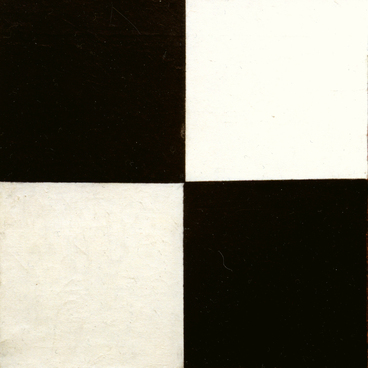Aleksandr Grigoryevich Sitnikov is a luminary among that community of artists that came into being in the 1970s. His painting, My daughter has a beautiful mom, belongs to those lyrical canvases from the late 1970s and early 1980s that are characterized by simplified forms, as well as an affinity to Russian icon painting in the figurative representation of the images, and in the symbolism of the color, gestures, and poses. The painting is a family portrait where the artist portrayed himself, his wife, the artist Olga Bulgakova, and his small daughter, Natalya.
This is not a realistic portrait of a specific family, but rather an allusion to an image of the Holy Family. The mother and daughter sitting on her knees are clothed in long, white garments. In their poses, the artistic canon from ancient Egypt can be clearly inferred, strictly replicated in the figure of the mother and somewhat softened by a three-quarter rotation for that of the child. The face and legs of the seated woman are depicted in profile so that both legs are visible, and the torso and eyes face forward. The proud posture, white garments, and ancient Egyptian figurative canon make her look like a Russian empress related to the gods.
Himself - the father of the family - the artist depicts in front of an easel, drawing a dove that the daughter holds in her hands. On the easel, the white dove in the girl’s hands turns into a sky blue color. Through this repetition, the father encounters his daughter metaphysically. He is connected to his wife by a green pear that has a red core, which makes an allusion to an apple, a fruit that symbolizes the relationship between a man and a woman. In Biblical mythology, Eve gives Adam an apple, and in Greek lore, Paris gives it to the goddess of Love, so one person - either a man or a woman - takes on a lot of initiative and responsibility. In Sitnikov’s interpretation, a man and a woman share this responsibility equally between themselves, and the symbol loses any overtone of an offer, seduction, and one partner choosing the other. Nobody is offering this fruit to anyone, and it is as if it hangs in space, between the fingers of two people. They only lightly brush their fingers against the pear, which takes on a new, symbolic color - man and woman unite and connect with each other in a harmonious, mutually complementary union, both spiritually and physically.
The artist’s face resembles the iconographic faces of saints. Like the child’s face, it has a three-quarter turn, only in the opposite direction. The figure, in contrast to the female, is somewhat relaxed and stooped over, and the meaning justified this: he works, creates, and she poses, sitting regally on the throne. The family is in a conditionally beautiful space, where kindness and happiness exist, consisting of expressively joyful paint strokes that are light in color, with rainbow hues and different textures. All three figures are interconnected by means of gestures, touches, colors, and figurative and compositional responses and repetitions, and constitute a kind of closed system that protects the circle, barring any outside interference.




